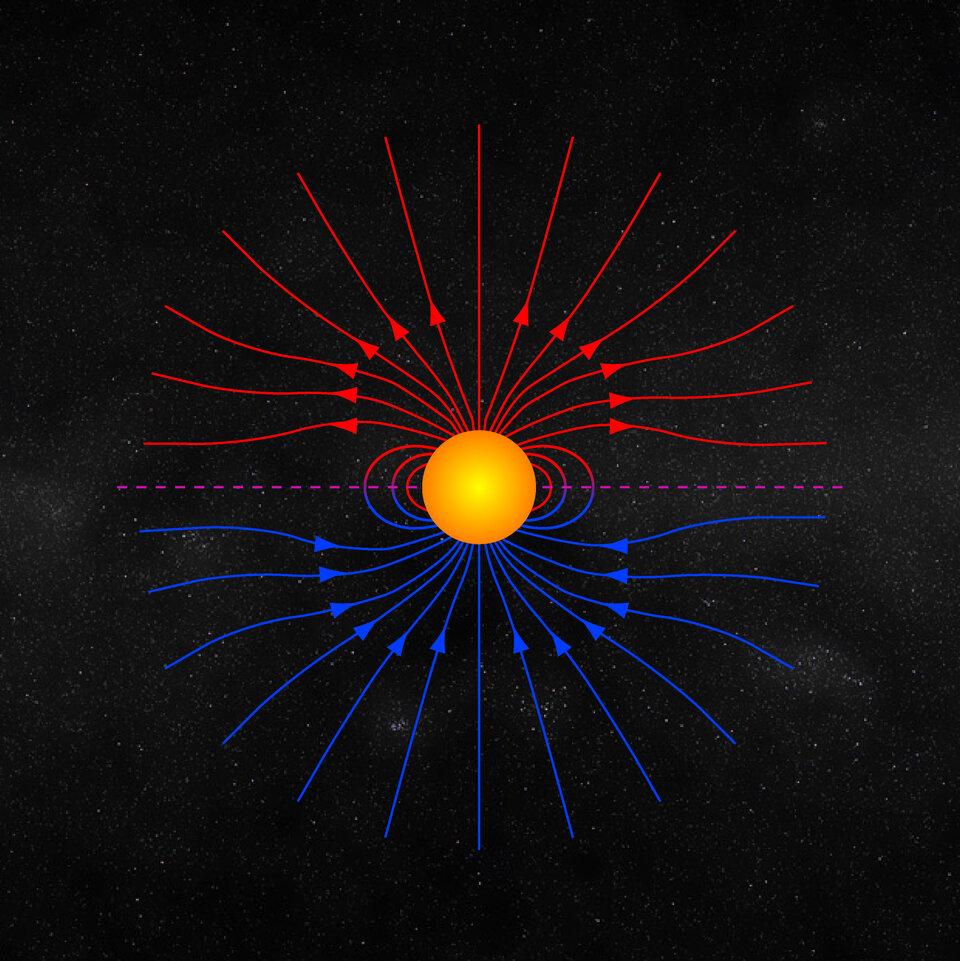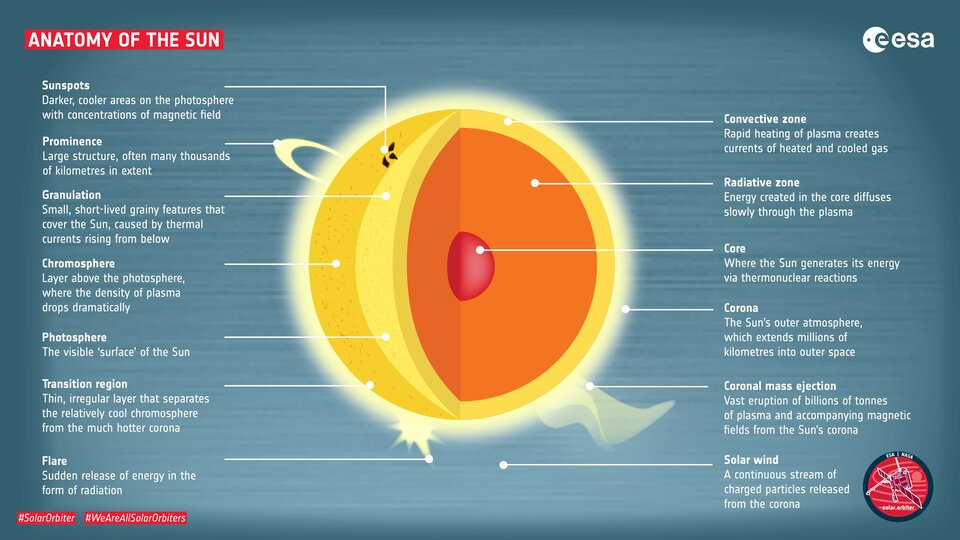The solar cycle, a heartbeat of stellar energy
The Sun follows a roughly 11-year rhythm of waking up and becoming very active before calming down again, a stellar beat known as the solar cycle. This affects Earth because it shapes space weather, determining how much radiation, magnetic field and particles the Sun flings out into space and towards our planet.
What is the solar cycle?

Like a bar magnet you may have used at school, the Sun has a magnetic field with north and south poles, and magnetic field lines stretching out far beyond the star itself connecting the polar regions. The source of this field is the constant movement of electrically charged particles within the Sun.
The Sun’s magnetic poles tend to switch places around every 11 years, with north becoming south and south becoming north. This periodic change is known as the solar cycle.
Importantly, reversing a magnetic field is a messy affair. As a result of the Sun’s magnetic field twisting and reshaping itself, the Sun sends out massive amounts of energy and streams of charged particles into space. When this ‘space weather’ hits Earth, it can affect telecommunication, navigation and weather services, and even disrupt power grids.
The magnetic field flips when the Sun is at its most active, in a phase called the solar maximum. After the flip, our star calms down until it reaches the solar minimum and a new cycle begins. This decrease in solar activity means fewer disturbances in space that could affect Earth.

What happens when the Sun ‘wakes up’?
While the Sun can send out bursts of radiation and particles at any time during the solar cycle, it becomes much more active in the years around the solar maximum. This restless activity can be linked to our star’s constantly shifting magnetic field.
Many solar outbursts come from regions with sunspots, also called active regions, because the Sun’s magnetic field is particularly strong there. Sunspots look like dark spots because the strong magnetic field restricts the motion of charged particles, making them cooler than their surroundings.
Solar flares occur when the magnetic energy stored in these active sunspot regions is suddenly released. The resulting burst of X-rays and other radiation travels across the Solar System at the speed of light.
Sometimes, the Sun flings out large amounts of solar material in the form of 'coronal mass ejections' (CMEs). These are massive bubbles of charged particles (plasma) threaded with magnetic field lines and are often triggered by solar flares.
Solar flares or shock waves from CMEs can also accelerate protons or other particles around the Sun to extremely high speeds. These are called solar energetic particles.

How does the solar cycle affect Earth?
By impacting space weather, the solar cycle’s influence extends well beyond the Sun itself. Earth's magnetic field and atmosphere shield us from the worst of the Sun's outbursts. However, space weather can pose a serious risk to spacecraft and astronauts, as well as affecting communication, navigation and power grids on Earth.
The electromagnetic radiation from solar flares directly affects the ionosphere (the upper, charged layer of Earth's atmosphere) and radio communications.
When Earth gets hit by a coronal mass ejection, this can deform Earth’s protective magnetic field and cause a geomagnetic storm. These storms can affect satellites, disrupt navigation systems, and cause power outages.
With society relying more on technology and space-based infrastructure like satellites, the risk of economic damage due to solar activity is increasing. The most intense geomagnetic storm we know of was the 1859 Carrington Event; “The damage estimates range from multiple billions up to three trillion euros in case of an event of comparable magnitude,” notes Holger Krag, Head of ESA's Space Safety Programme Office.
A more harmless visible effect of solar activity is the spectacular auroras – northern and southern lights – which are caused by charged particles (that were mostly already trapped in Earth's magnetic field) interacting with the atmosphere near the poles.

Can we predict the solar cycle?
By tracking solar activity and the solar cycle, we can better prepare for solar storms and ensure the protection of our critical technological infrastructure. But predicting when exactly the peak of the solar cycle will arrive, and just how active the Sun will be before, during and after the solar maximum, is a notoriously difficult task.
Sunspots are a useful tool to determine where the Sun is in its cycle. The number of sunspots peaks around the solar maximum, and dips around the solar minimum.
The Sunspot Index and Long-term Solar Observations (SILSO) project (Royal Observatory of Belgium) and the Space Weather Prediction Center (NOAA, US) both monitor the number of sunspots and use historical data and sophisticated models to predict how the solar cycle will progress.
What are ESA's eyes on the Sun?
ESA has multiple space missions and instruments studying the Sun, because learning about our star is key to predicting its potentially hazardous activity. This includes missions such as Solar Orbiter, SOHO, Proba-2 and the upcoming Proba-3.
Other missions, including Cluster, Swarm and SMOS, measure the effects of solar activity at Earth and increase our understanding of how our atmosphere and magnetic field work. They will soon be joined by the Smile mission, which will take the first X-ray images and videos of the solar wind slamming into Earth’s protective magnetic bubble, and its complementary ultraviolet images will provide the longest-ever continuous look at the northern lights.
Monitoring current space weather is a core activity of ESA’s Space Weather Office, part of the Agency’s Space Safety programme. Their goal is to continuously observe, monitor, understand and predict all potential hazards emanating from our star. Our growing space weather service network helps monitor and predict space weather for the many different industries and organisations impacted by it.
Space weather services will greatly improve once ESA’s Vigil mission launches in 2031. With its scientific instruments – including ones similar to those on Solar Orbiter – Vigil will monitor the side of the Sun. By spotting areas of solar activity days before they rotate into Earth's view, Vigil will provide early warnings for hazardous solar events.
As we deepen our understanding of solar activity and its impact on Earth, what solar secrets might our spacecraft reveal to us next?















 Germany
Germany
 Austria
Austria
 Belgium
Belgium
 Denmark
Denmark
 Spain
Spain
 Estonia
Estonia
 Finland
Finland
 France
France
 Greece
Greece
 Hungary
Hungary
 Ireland
Ireland
 Italy
Italy
 Luxembourg
Luxembourg
 Norway
Norway
 The Netherlands
The Netherlands
 Poland
Poland
 Portugal
Portugal
 Czechia
Czechia
 Romania
Romania
 United Kingdom
United Kingdom
 Slovenia
Slovenia
 Sweden
Sweden
 Switzerland
Switzerland
























